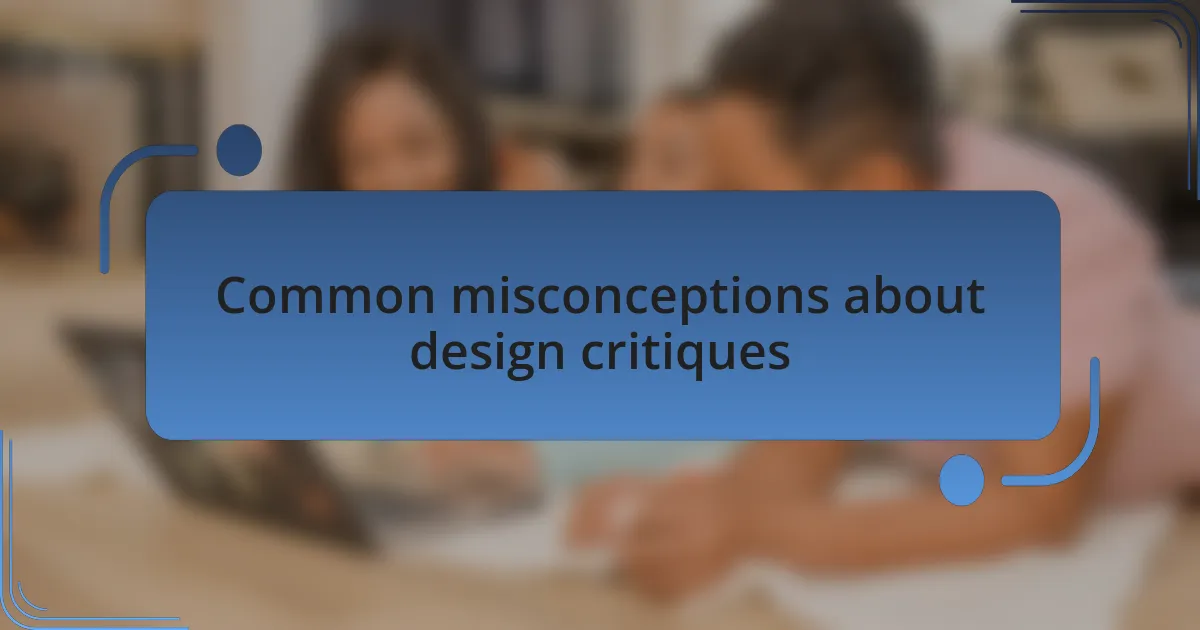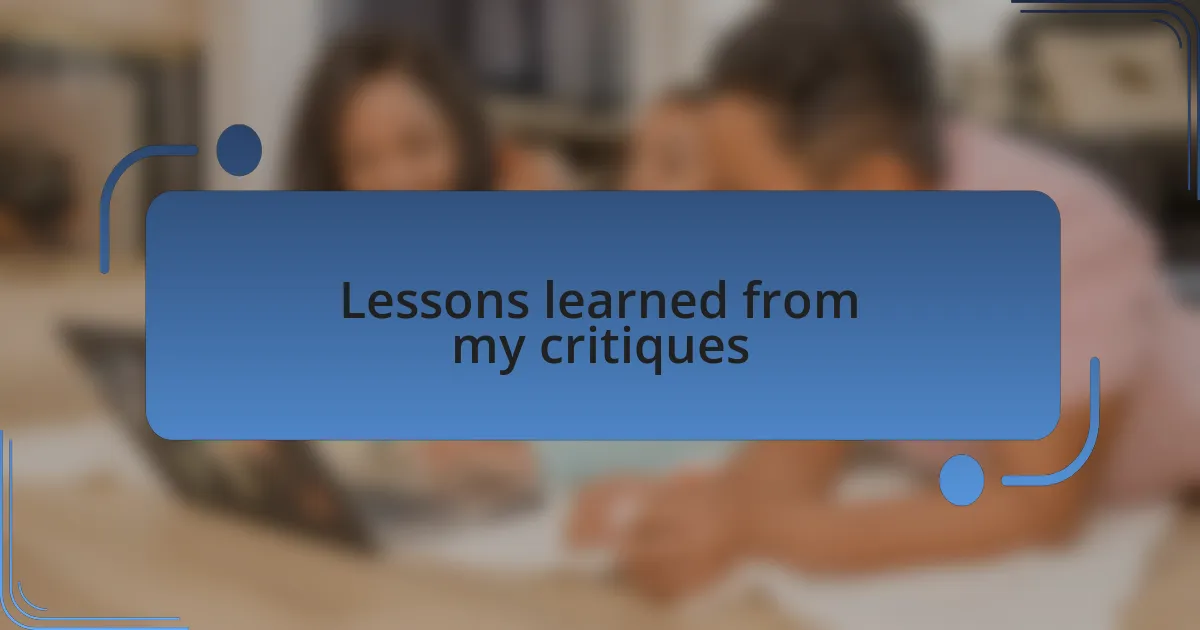Key takeaways:
- Design critique sessions foster collaboration and diverse perspectives, leading to enhanced design processes.
- Critiques should focus on collective improvement rather than on criticism, and valuable feedback can come from anyone, regardless of experience.
- Active listening and reflecting on feedback over time can significantly enrich the design approach and effectiveness.
- Applying feedback requires a mindset shift; documenting insights helps track design evolution and informs future projects.

Understanding design critique sessions
Design critique sessions are foundational to refining our vision and approach. I still remember my first session; the nerves were palpable, and I wondered if my ideas would withstand scrutiny. It turned out to be liberating—receiving constructive feedback transformed my design process.
During these sessions, collaboration becomes paramount. Each participant brings their unique perspective, and honestly, sometimes it feels like a puzzle. I recall one instance where a teammate pointed out a detail I had missed. That small nudge opened my eyes to a whole new angle I hadn’t considered before. How often do we miss opportunities for growth simply because we shy away from sharing our creations?
Listening is as crucial as voicing our thoughts in these critiques. I’ve learned that the best insights often come from the most unexpected sources. Have you ever found yourself surprised by a comment that completely changed your perspective? I have, and those moments are invaluable. Embracing feedback, especially when it challenges our preconceived notions, ultimately leads to stronger and more effective designs.

Common misconceptions about design critiques
It’s a common mistake to think that design critiques are simply an opportunity for others to point out flaws. I used to dread these sessions, feeling like I was exposing my work for harsh judgment. However, I learned that critiques are more about collaboration than criticism. They create a space for collective improvement rather than a platform for singling someone out.
Another misconception is that only the most experienced designers can provide valuable feedback. I vividly remember a critique where a junior designer shared a fresh perspective that enlightened the entire team, myself included. Their inexperience didn’t diminish the quality of their insights; rather, it highlighted how crucial diverse voices are in the design process.
Lastly, many believe that design critiques should yield immediate solutions. In my experience, this is rarely the case. Sometimes, a critique raises more questions than answers, which is equally valuable. I’ve found that the real growth comes days or even weeks later as I reflect on the feedback and discover deeper layers to my designs. Why rush to solve everything when the insights can lead to a richer outcome over time?

Lessons learned from my critiques
It was during one of my first critique sessions that I realized the real treasure lies in the questions being asked. A colleague once asked why I chose a specific color palette, which made me rethink my choices deeply. This simple inquiry transformed my understanding of color theory in design, illustrating how a single question can unlock layers of insight that I hadn’t considered before.
I also learned the importance of actively listening to feedback without being defensive. I remember a time when a participant pointed out that my layout felt cluttered. Initially, my instinct was to defend my choices, but when I took a step back, I could see their point. Embracing feedback rather than resisting it has turned out to be crucial for growth, ultimately making my designs more effective and user-friendly.
Another lesson was understanding that not all feedback requires immediate action. There are countless times I’ve left a critique with a flood of ideas but later realized that some feedback was more aligned with my vision than others. Reflecting on these insights over time has helped me to curate my design approach, ensuring that I adapt only the suggestions that resonated with my intention. Isn’t it fascinating how critique can shape our journey, often in unexpected ways?

Practical tips for effective feedback
When giving feedback, I’ve found that phrasing my thoughts with “I” statements can make a big difference. For instance, instead of saying, “This doesn’t work,” I might say, “I feel like this design choice might not resonate with users.” This approach not only softens the critique but also invites discussion rather than stifling it. Have you ever thought about how the way you frame your feedback can impact the recipient’s openness to it?
One practical tip is to focus on the goals of the project when offering feedback. During one session, I realized that aligning my comments with the project’s objectives helped clarify my points. It shifted the conversation from subjective opinions to constructive suggestions aimed at improving the overall design. Isn’t it refreshing when discussions become less about personal taste and more about fulfilling a shared vision?
Additionally, I’ve learned the value of providing specific examples along with my suggestions. For instance, rather than simply saying that a text is difficult to read, I might point out that adjusting the font size and contrast could enhance readability. This not only gives the designer a clear path to improvement but also demonstrates that my feedback is based on thoughtful analysis. Isn’t it amazing how a little specificity can transform vague comments into actionable insights?

Applying feedback to improve designs
When it comes to applying feedback, I’ve often found that revisiting my designs after a critique session can be both enlightening and daunting. I remember a time when colleagues pointed out that the color scheme I loved felt too overwhelming. After stepping back and integrating their feedback, I realized that a softer palette not only aligned better with user expectations but also created a more inviting atmosphere. Have you ever experienced that moment of clarity when you adjusted your design and suddenly saw it in a new light?
Working with feedback requires a mindset shift; it’s about embracing growth. I vividly recall a design project where I had to incorporate user testing insights. Initially resistant to changing certain elements, I eventually recognized that their perspectives were invaluable. By applying those changes, I not only enhanced usability but also learned to appreciate the collaborative nature of design. Doesn’t it feel good knowing that each piece of feedback is a stepping stone to something greater?
One effective method I’ve adopted is creating a feedback log—essentially a living document that tracks suggestions and adjustments. This technique allows me to visualize how my designs evolve over time. I often go back to it, reflecting on previous critiques and the changes I made in response. It’s fascinating to see how far I’ve come, and it helps me to remain open to future insights. Have you tried tracking your feedback in a similar way? It might just deepen your understanding of your design journey.